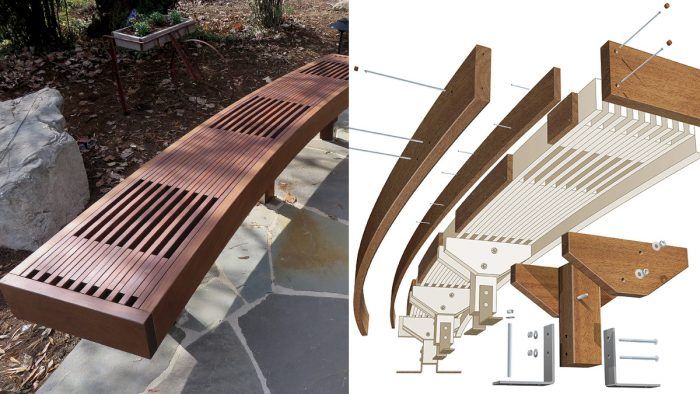How to Build a Curved Ipé Garden Benches
Clamps and lots of screws put a bend in this dense and durable wood.

Synopsis: Ipé is well known as a beautiful and durable wood for building decks. In this article, however, carpenter Trip Renn uses it to build a pair of curving benches that soften the hardness of a stone patio. Ipé is an incredibly dense wood, and Renn explains how he built simple benchtop forms to bend the ipé and how he screwed the boards together, forming a permanent bend. Locally made stainless-steel brackets hold the benches to the patio, while creating an airspace below the legs to enhance their longevity.
As the owner of a company, I have two functions: one, fretting; and two, saying, “Yes, we can do that.” Fortunately, the high quality of my crew keeps the fretting to a minimum and has so far bailed me out of all the unlikely projects I have said yes to. This project was no exception. Frequent clients Susan Sharpe and Nancy Duffner initiated an extensive landscaping project and asked us to handle the woodwork. The plans called for two curved benches made of ipé. The faces and ends of the bench would be 2×6, and the centers would be 1×4.
My initial reaction was that it would be a piece of cake to bend 12-ft. ipé 2x6s and create a bent lamination by screwing it to the 1×4 layers. For the bench to straighten itself out, each piece of the lamination would have to move in relation to the pieces on either side of it. By fastening the laminations so that they couldn’t move in relation to one another, the bench as a whole would retain the curve. I didn’t take into account how much ipé would resist bending.
Wrestling with ipé

The plans called for a 12-ft. bench and an 8-ft. bench, and they gave the curve as increments of deviation from a straight line at every foot of the length. My crew and I used this to position clamping blocks on a 3/4-in. CDX plywood table. The blocks themselves were 2x4s screwed together in a T-shape. Their 5-in. height was perfect, and they provided a wide-enough base to screw to the table. The plan was helpful, but the curves also could have been laid out on the plywood using a fairing stick. A fairing stick is a thin piece of clear, straight-grained wood that bends to the curve you’re trying to achieve. Often, a string is used to adjust and fix the curve, just like on an archer’s bow.
My education in the obstinacy of ipé began with my attempt to bend the first 2×6. I clamped one end of a 12-footer to a block that was screwed to the bench top. When I brought the opposite end about halfway to the other end block, the first block ripped from the table and whipped across my little shop.
My crew saved me from my initial optimism. They strengthened my clamping table, using more screws to affix the clamping blocks and clamping the 2×6 to the table itself. Then we began laying up the pieces of ipé that comprise the bench: the 2×6 front (inner curve), followed by 12-ft. 1x4s alternating with 1×4 intermittent spacers. Finally came the 2×6 back (outer curve). All of the members ran long and were cut to length later. The 2x6s had to be clamped down with heavy timber cauls to counteract their tendency to lift off the table as they bent.
From Fine Homebuilding #282
To view the entire article, please click the View PDF button below.
Fine Homebuilding Recommended Products
Fine Homebuilding receives a commission for items purchased through links on this site, including Amazon Associates and other affiliate advertising programs.

Graphic Guide to Frame Construction

A Field Guide to American Houses

All New Kitchen Ideas that Work


























